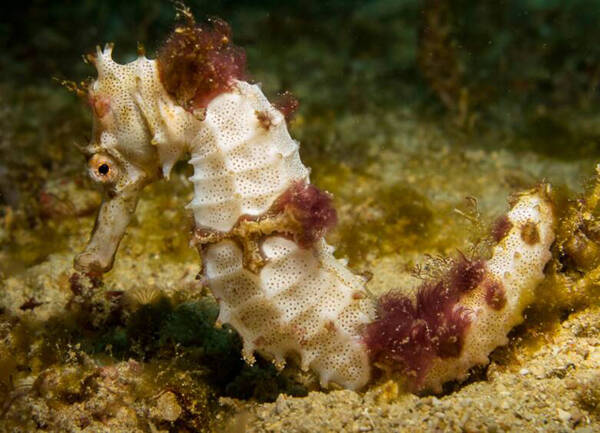Hedgehog Seahorse is a fish of the Syngnathidae family and the genus Hippocampus.

Hedgehog Seahorse mainly feeds on small crustaceans and other planktonic invertebrates. Hedgehog Seahorse is oviparous. During reproduction, the female uses an ovipositor to transfer the eggs to a brood pouch under the male's abdomen. The male incubates and nourishes the developing embryos before giving birth to independent young. The male not only fertilizes the pouch and provides physical protection for the developing embryos, but also osmo-regulates the environment within the pouch, ventilates the embryos, and may provide some nutrition until they fully hatch.
The global population of spiny seahorses has not been estimated (2016), but trade and survey analyses conducted by the Seahorse Project indicate that spiny seahorses are widely used in traditional medicine, aquarium trade, etc. Evidence from fisher surveys indicates that the availability and catch of local seahorses, including spiny seahorses, have declined in the Philippines, Malaysia, and Thailand, and that most spiny seahorses are caught as bycatch (2010). It is suspected that similar population declines have occurred across the species' range, where the same threats are found (FAO 2001; Perry et al. 2010). If reported declines are extrapolated to 2016, declines of seahorses (including H. spinosa) in Malaysia are estimated at 58%, and declines of seahorses (including H. spinosa) in Thailand are estimated at 56-88% (Perry et al. 2010). Fishermen in the Philippines reported high-level declines in catches of seahorses (including H. spinosa) between 1970 and 2003 (O'Donnell et al. 2010). Overall, the declines reported by these fishers and the continued intensification of fisheries in some areas suggest that populations of H. spinosa may have declined by at least 30% over the past decade (2016).
Filipino fishermen point to overfishing, increasing numbers of fishermen, and indiscriminate fishing (including of pregnant and immature seahorses) as the main reasons for the decline in the spiny seahorse population. The spiny seahorse is also one of the two most reported species in the seahorse trade, and the large amount of legal and illegal trade throughout the species' range indicates that overfishing has put great pressure on the survival of this species. The life history and ecological characteristics of spiny seahorses may increase their susceptibility to these threats.
The Australian distribution of spiny seahorses is protected under the Environment Protection and Biodiversity Conservation Act 1999, so export permits are now required for trade and fishing. The Philippines has a national ban on the capture and trade of spiny seahorses under the Philippine Fisheries Code of 1998: Republic Act No. 8550. Other countries such as Cambodia, China and Sri Lanka also have laws prohibiting the trade of spiny seahorses (UNEP-WCMC 2012). Since 2001, all seahorses have been listed in Schedule 1 of the Indian Wildlife Protection Act, which prohibits trade in these species (Indian Ministry of Environment and Forests 2001).
Listed on the IUCN Red List of Threatened Species (IUCN 2016 ver 3.1) - Vulnerable (VU).
Listed in Appendix II of the Convention on International Trade in Endangered Species of Wild Fauna and Flora (CITES).
Protect wild animals and eliminate game.
Maintaining ecological balance is everyone's responsibility!